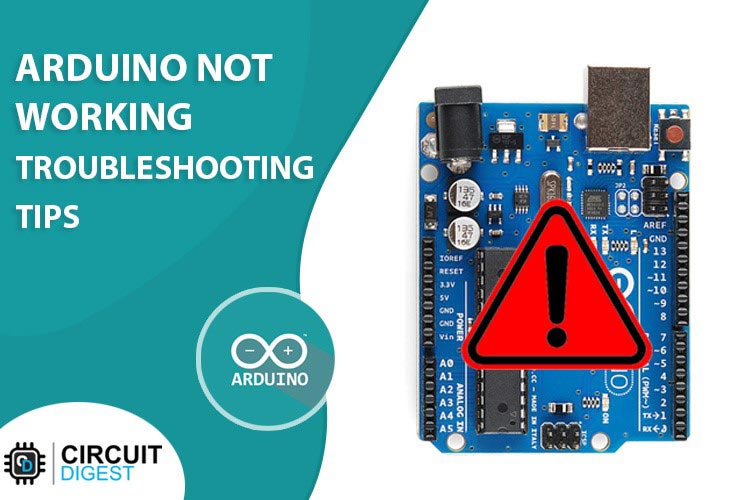
The Arduino platform is one of the most popular platforms for electronics enthusiasts and hobbyists for building electronic projects. Sometimes an Arduino board may not work as you might have expected and you might be wondering what the problem is. In this blog, we will learn the reasons why your Arduino board may not be working and how to solve it.
You can also go through our previous Arduino common problems blog or learn more about Arduino projects on our website
Let’s go through the problems one by one
Arduino not Powering Up
So, you’ve bought yourself a new Arduino. you plug your USB cable and it’s not powering up. No power led. No Rx or Tx led’s working. Let’s see what can be the issues:
If your Arduino is not showing any signs of powering up…you might check the following issues to sort your problem: -
Faulty Cable Issue:-
- Inspect the cable for any signs of physical damage, such as frayed wires, kinks, or loose connections. If you see any type of damage, replace it.
- Testing the cable: Use a multimeter to test the continuity of the cable. Test for continuity between each pin of the cable to ensure that it is properly connected.
- Try a different cable: If you have another cable, try to use it to connect the Arduino to the power source or your computer. If the Arduino works with the new cable, then the old cable is likely the issue.
- Check the USB port: If you are using a USB cable to connect the Arduino to the computer, try using a different USB port. Sometimes, a faulty USB port can cause connection issues.
- Check the power supply: If you are using a power supply (I.e., power bank, adapter etc) to power the Arduino, make sure it is giving enough voltage and current. If the power supply is faulty, it can cause connection issues.If you have checked the cable and tried the above steps, but the Arduino still does not work, then it is possible that the issue is not related to the cable. In that case, you may need to troubleshoot.
Voltage Regulator Faulty Issue:-
If you suspect that your AMS1117 voltage regulator is faulty in your Arduino project, here are some steps you can take to check and fix the issue:
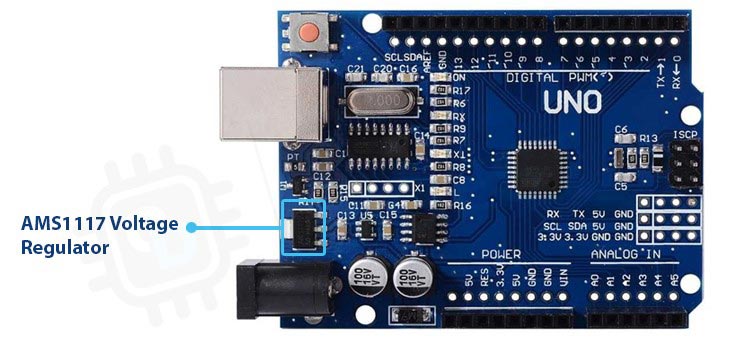
- Check the complete voltage regulator for any discrepancy visually.
- Measure the input voltage of the ams1117 to ensure it is within the regulator's input voltage range provided in the datasheet. If the input voltage is higher than expected, consider adding a voltage divider or a Zener diode to reduce the input voltage to within the regulator's specified range.
- Check the output voltage of the regulator and check that it is stable and within the expected range. If the output voltage is unstable or too low, test the capacitors on the input and output sides of the regulator. They should be within the recommended values and securely connected.
- Check the regulator's current load capacity by measuring the current draw of the load and comparing it to the regulator's maximum output current rating in its datasheet. If the load current is more than the regulator's max output current rating, use a higher current rating regulator or add an extra regulator to share the load.
- add a heat sink to the regulator to help dissipate heat and avoid a thermal shutdown.
- Replace the faulty AMS1117 with a new one from a reliable supplier.
Atmega IC Faulty Issue:-

The majority of Arduino boards are controlled by the Atmega IC microcontroller chip. Here are some steps you can take to address the problem if you believe that the Atmega IC on your board is faulty:
- Visual inspection: Look for any obvious symptoms of Atmega IC damage on the Arduino board, such as fractures, burns, or discoloration.
- Verifying the connections: ensure that the Atmega IC is securely fastened to the circuit board and that none of the connectors or pins are flimsy.
- Trying a different Atmega IC: If you have an additional Atmega IC or have access to one from another Arduino, consider swapping it out for the problematic one. If the Arduino functions properly with the new Atmega IC, the problem is with the older IC.
- Testing with a programmer: If you have a programmer that is external, you can connect to it to test the functionality of the Atmega IC. Further setup will be necessary, such as the installation of the required drivers and software.

- Changing the Atmega IC: If none of the aforementioned solutions resolve the problem, this step is required. To fix the broken IC on the Arduino board, get a replacement IC online or from a nearby electronics retailer.
Removing the Atmega Chip can be challenging and calls for some soldering expertise.
Serial Converter Faulty:-

If you believe that the serial converter on your Arduino board is broken (it's most likely a ch340 or cp2102). You can take the following actions to address the problem:
- Look for connections: Check that the serial converter is securely attached to the board and that no connections or pins are loose.
- Using a separate USB cord to check: Try a new USB cord if you are using one to connect the Arduino to the computer. An unreliable USB cord may occasionally result in connectivity problems.
- Try connecting the Arduino to a separate system to test with a different computer (PC).
- Examining the USB port: If you are connecting the Arduino to the computer with a USB cable, try a different USB port. An unreliable USB port may occasionally result in connectivity problems.
- Verifying the power source: Verify that the power supply is supplying the Arduino with sufficient voltage and current. Connection problems may be brought on by a malfunctioning power supply.
- Replace the serial converter: If none of the aforementioned measures work to solve the problem, a new serial converter may be required. A replacement serial converter is available from stores or online.
Main Capacitor Faulty:-

An Arduino board's primary capacitor aids in power supply stabilization and filtering. These are some steps you can take to solve the problem if you think the main capacitor is faulty:
- Visual inspection: Check the capacitor visually for any obvious symptoms of damage, such as cracks, bulging, or leakage.
- Test with a multimeter: A multimeter can be used to measure the capacitor's capacitance. The capacitance value must be same as the the value listed in the documentation for the Arduino board.
- Checking the power supply: Check that the power source is supplying the Arduino board with the proper voltage and current. The primary capacitor may have some troubles as a result of a bad power supply.
- Changing the capacitor: You must replace the capacitor if it is faulty. The defective capacitor on the Arduino board can be swapped out with a new one by placing an online purchase or visiting a nearby electronics retailer. Make sure the capacitor you choose has the same capacitance and voltage specifications as the original capacitor.
Polyfuse Faulty:-
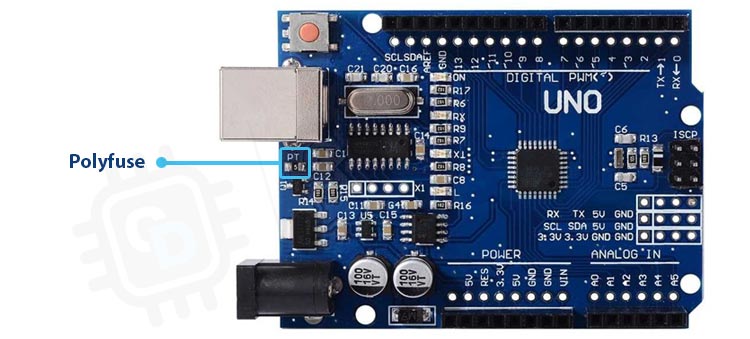
Polyfuses are resetting fuses that shield an Arduino board's electronic parts from overcurrent and short circuits. Here are some steps you can take to troubleshoot the problem if you think your Arduino board's polyfuse is defective:
- Visual inspection: Check the polyfuse for any cracks, bulges, or other outward indications of damage.
- Test with a multimeter: A multimeter can be used to measure the polyfuse's resistance. While the polyfuse is in its normal state, the resistance should be low, and when it is blown, the resistance should be high.
- Verify continuity: Examine continuity across the polyfuse using a multimeter. When the polyfuse is in its normal state, there should be continuity; when it is in its blown state, there should be none.
- Check the power supply: Ensure that the power source is supplying the Arduino board with the proper voltage and current. The polyfuse may experience problems as a result of a bad power source.
- Change the polyfuse: If the polyfuse is defective, you must change it. You can replace the defective polyfuse on the Arduino board by placing an online or offline order for a replacement polyfuse.
Diode Faulty:-
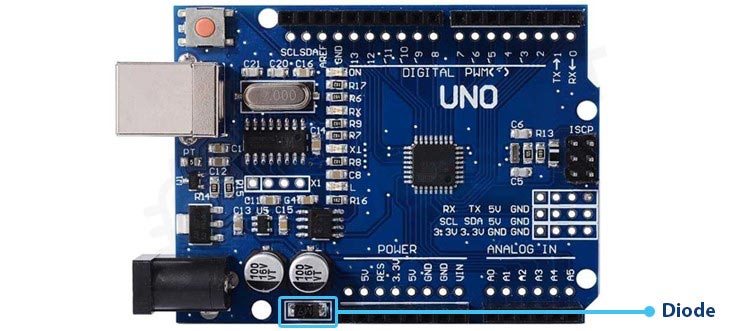
Diodes are used on an Arduino board to stop voltage spikes and restrict the direction in which current can go. If a diode on your Arduino board is broken, use these steps to fix the issue:
- Visual inspection: Check the diode for any signs of damage, such as cracks or discoloration.
- Do a multimeter test: Measure the voltage drop across the diode using a multimeter in both- forward and reverse orientations. The voltage loss should be within the ranges specified in the Arduino board's documentation. To get started with Multimeter, follow the link.
- Do a continuity test by using a multimeter to look for continuity across the diode. The forward direction should go on forever, but the reverse direction shouldn't.
- By examining the diode continuity, you may examine the power supply. Check to see that the power supply is providing the right voltage and current to the Arduino board. A bad power source could cause complications for the diode.
- Replace the diode: If the diode is broken, you must do so. Get a replacement diode online or at a nearby electronics store to repair the broken one on the Arduino board.
Board not in Sync

The "Board not in Sync" error message in Arduino IDE typically means that the computer is unable to establish communication with the Arduino board. This can happen due to various reasons, such as incorrect board selection, damaged USB cable, or wrong port selection.
Here are a few steps you can try to resolve the "Board not in Sync" error:
- Ensure that the correct board is selected under the "Tools" menu. Check if the board type matches the one, you're using.
- Check if the correct serial port is selected under the "Tools" menu. If you're unsure which port to select, disconnect the board, and see which port disappears from the list. Reconnect the board and select the corresponding port.
- Try a different USB cable or USB port. A damaged USB cable or a faulty USB port can prevent communication between the computer and the board.
- Press the reset button on the board while uploading the code. Some boards require you to press the reset button once the upload starts to get them into the bootloader mode.

- Try uploading the code using another computer. If none of the above step’s work, try using a different computer to eliminate the possibility of a software or hardware issue with the original computer.
- If none of the above step’s work, there may be a hardware issue with the board that needs further investigation.
Wrong COM Port

This error in Arduino IDE means that the serial port which is selected is not the correct one for the Arduino board that you have connected. This happens when the board is not recognized by the computer or if multiple devices are connected to the computer, making it difficult to identify the correct port.
Here are a few steps you can try to resolve the "Wrong COM Port" error:
- Disconnect the Arduino board from the computer and reconnect it.
- Check the Device Manager or System Information to see if the Arduino board is there under the Ports section. If it's not listed, the computer may not recognize the board, or there could be an issue with the USB cable or the board itself.
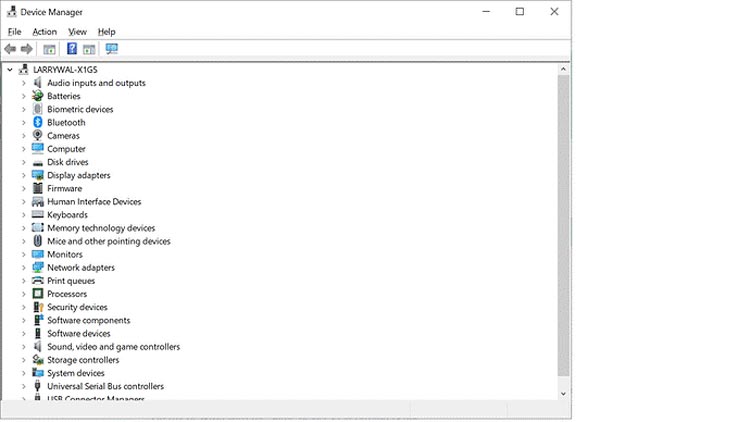
- Check that the correct board is selected under the "Tools" menu. Check if the board type matches the one, you're using.
- Check if the correct serial port is selected under the "Tools" menu. If you're unsure which port to select, disconnect the board, and see which port disappears from the list. Reconnect the board and select the corresponding port.
- Try a different USB cable or USB port. A damaged USB cable or a faulty USB port can prevent communication between the computer and the board.
- Restart the computer and the Arduino IDE. Sometimes, a simple restart can help resolve the issue.
- If none of the above steps work, there may be a hardware issue with the board that needs further investigation.
avrdude: stk500_getsync (): not in sync: resp=0x00

"avrdude: stk500 getsync (): not in sync: resp=0x00" often indicates that the computer is not able to connect to the Arduino board. This error can happen various reasons, including choosing wrong board, wrong port, having a corrupt bootloader, or a damaged USB cord.
To fix the "avrdude: stk500 getsync(): not in sync: resp=0x00" problem, try the following steps:
- Check that your board is chosen in the "Tools" menu. Also check that the board type corresponds to the one you are using.
- Verify that the proper serial port is chosen in the "Tools" menu. Disconnect the board and see which port vanishes from the list if you're confused which port to choose. Choose the appropriate port and reconnect the board.
- Test a different USB port or cable. Communication between the computer and the board can be hampered by a broken USB cable or a defective USB port.
- While uploading the code, press the reset button on the board. Some boards require you to click the reset button once the upload starts to bring them into the bootloader mode.
- Try using a different computer to upload the code. If none of the above measures are successful, the board may have a hardware problem that requires additional research.
Arduino Board not Recognized

This indicates that the Arduino board is not recognised by the computer. A broken USB cable, improper driver installation, or a hardware problem with the board are just a few causes of this message.
You can try the following things to fix the "Arduino board not detected" error:
- Verify that the USB cable is securely attached to the computer and the board. To test whether it fixes the problem, try some other USB cord.
- Check that the board is turned on. Some boards need a battery or an external power source to operate effectively.
- To see if the Arduino board is visible under the Ports section, check the Device Manager. If it isn't listed, there might be a problem with the USB cable or the board itself, or the computer might not be able to recognize the board.
- Setting up the board's proper driver. A particular driver needs to be installed on the computer to support some boards. To get the correct driver and installation instructions, visit the manufacturer's website.
- Restart the Arduino IDE and the computer. Sometimes all it takes to fix something is a restart.
- Examine another USB port. The computer may be unable to recognize the board due to a broken USB port.
- Try utilizing the board with a different computer. To rule out the potential that the original computer has a software or hardware problem, try utilizing the board on another computer if none of the previous methods work.
Bootloader Issue
Here are a few things you can do to solve the issue if you are having bootloader issues and none of the solutions mentioned above are working for your Arduino board:
- Verify your USB cable: As you connect your computer to the Arduino board using a USB cable, check that everything is working properly. To test whether it fixes the problem, try a different USB cord.
- Make sure you chose the right board and serial port in the Arduino IDE by checking your selections. Choose the proper board type and port from the "Tools" menu. Unplug the board, check the list of possible ports, plug the board back in, then check the list of ports once more if you are not sure which port to choose. The brand-new port that pops up must be the right one.
- Clear the screen: By pushing the reset button, try to reset the board. The bootloader will restart as a result, enabling programming mode to be accessed by the board. After the board has been reset, make sure to immediately begin the upload procedure.
- Burn the bootloader again: You might need to do this if the bootloader on your Arduino board is corrupted or not operating properly. On our website are instructions for burning the bootloader. It should be noted that an ISP programmer or another Arduino board acting as a programmer is required for this process.
- Verify the fuse settings: Verify that the Arduino board's fuse settings are accurate. The board may not operate properly or the bootloader may not work at all if the fuse settings are off.
Serial Port Issues
![]()
Serial port issues in Arduino can occur due to various reasons, such as incorrect port selection, damaged USB cable, or a malfunctioning board.
Serial communication in Arduino refers to the process of sending and receiving data through the serial port of the Arduino board. Serial communication can be established between the Arduino board and another device such as a computer, another Arduino board, a sensor, or a display.
Here are the few common issues beginners face with serial communication are
Serial Port Already in Use:-

If you are getting a "Serial Port Already in Use" error message when trying to upload code to your Arduino board or trying to open the Serial Monitor, it means that the port you are trying to use is currently being used by another application or process on your computer. Here are some steps you can take to resolve this issue:
-
Close any other applications that may be using the serial port: Make sure that no other programs or applications are using the serial port that you want to use with your Arduino board. This could include other instances of the Arduino IDE, serial terminal software, or any other programs that use serial communications.
-
Disconnect and reconnect the Arduino board: Try disconnecting the USB cable from the Arduino board and then reconnecting it to see if that releases the serial port.
-
Restart your computer: Sometimes, the issue may be caused by a conflict with another software or process that is running on your computer. Try restarting your computer to see if that helps.
-
Use a different serial port: If your computer has multiple USB ports, try using a different port to see if that resolves the issue.
-
Check your code: Make sure that your code is not holding the serial port open or using it in a way that prevents other programs from accessing it.
If none of these step’s work, you may need to consult the Arduino forums or seek additional help from an expert.
Serial Port Menu Grayed Out: -
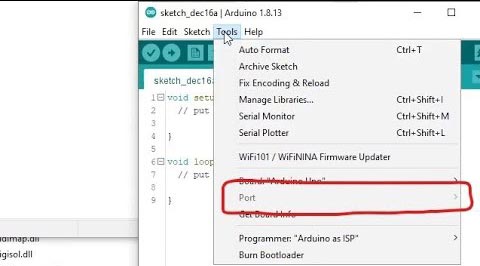
If the Serial Port menu is grayed out in the Arduino IDE, it usually means that the IDE is unable to detect any available serial ports on the computer. This can occur due to several reasons such as an incorrect board selected in the "Tools" menu, a damaged USB cable, or a malfunctioning board.
Here are a few steps you can try to resolve the issue:
- Ensure that the board is connected to the computer via a USB cable and powered on.
- Check if the correct board is selected in the "Tools" menu. If the board is not selected, the IDE may not be able to detect any available serial ports. Select the correct board from the "Tools" > "Board" menu.
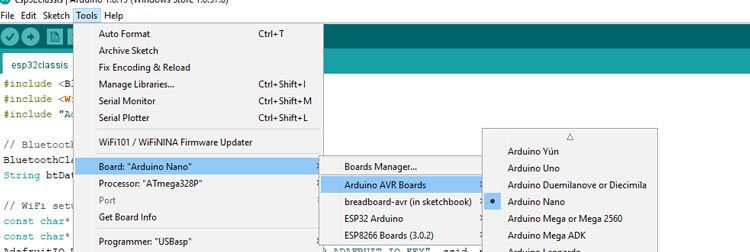
- Try using a different USB cable. Sometimes, a damaged USB cable can prevent the IDE from detecting the serial ports.
- Try using the board on another computer. If the board works on another computer, it may indicate a hardware or driver issue with the original computer.
- Reinstall the board's driver. Some boards require a specific driver to be installed on the computer. Check the manufacturer's website for the correct driver and installation instructions.
- Restart the computer and the Arduino IDE. Sometimes, a simple restart can help resolve the issue.
If none of the above step’s work, there may be a hardware issue with the board that needs further investigation.
Serial Monitor Not Working:-

If you are experiencing issues with the Serial Monitor not working, there are several steps you can take to troubleshoot the problem:
- Check your connections: Make sure your Arduino is properly connected to your computer and that the correct serial port is selected in the Arduino IDE.
- Restart your Arduino IDE: Sometimes, the Serial Monitor can become unresponsive due to a software glitch. Closing and reopening the Arduino IDE can help to fix this issue.
- Check your code: Make sure your code is properly written and that you have included the necessary Serial.begin() and Serial.print() statements.
- Adjust the baud rate: Try adjusting the baud rate setting in the Serial Monitor. Sometimes, the default baud rate of 9600 may not work for certain projects.
- Clear the buffer: If the Serial Monitor is displaying gibberish or incorrect data, try clearing the buffer by pressing the "Clear" button.
- Reset your Arduino: Try resetting your Arduino by pressing the reset button on the board. This can sometimes help to fix issues with the Serial Monitor.
- Try a different computer: If none of the above steps work, try connecting your Arduino to a different computer to see if the issue is with your hardware or software.
Sketch Too Large

If you are getting a "Sketch Too Large" error message when trying to upload code to your Arduino board, it means that the compiled code (or sketch) is too big to fit in the available program memory on the board. Here are some steps you can take to resolve this issue:
- Optimize your code: One of the most effective ways to reduce the size of your code is to optimize it. This involves removing unnecessary code, using more efficient programming techniques, and minimizing the use of libraries or other resources that consume a lot of memory. There are many online resources available that provide tips and best practices for optimizing Arduino code.
- Use a smaller board: If your code is too large to fit on your current board, you may need to consider using a smaller board with less program memory.
- Remove unnecessary libraries: Libraries are a convenient way to add functionality to your Arduino project, but they can also consume a lot of program memory. Consider removing any libraries that you are not using or finding alternative libraries that are smaller or more efficient.
- Use the F() macro for string literals: String literals (e.g. text messages) can consume a lot of program memory. To reduce their impact, you can use the F() macro to store them in flash memory instead of RAM.
- Use PROGMEM to store data in flash memory: If your code includes large arrays or other data structures that are consuming a lot of program memory, you can use the PROGMEM directive to store them in flash memory instead of RAM.
- Upgrade your hardware: If none of the above steps work and you absolutely need more program memory, you may need to consider upgrading to a board with more memory or using an external memory device.
By following these steps, you should be able to reduce the size of your code and resolve the "Sketch Too Large" error message.
Grounding Errors
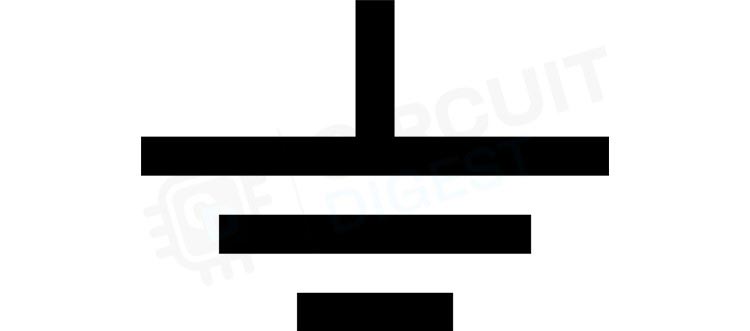
Many things, including as improper wiring, shoddy connections, and electrical noise, might result in grounding issues in Arduino. These are some methods you can take to investigate and fix grounding issues:
- Inspect your wiring: Verify that all of your connections and cables are secure and correctly linked. Errors in grounding can result from faulty or loose wiring.
- Employ a dedicated ground wire: In some circumstances, connecting all of the circuit's components to a dedicated ground wire may be beneficial. This can lower the possibility of grounding problems and increase your system's overall reliability.
- Isolate high-current and low-current wires: By doing this, you will lessen the chance that grounding errors will be caused by electrical noise and other types of interference.
- Employ shielded wires: Shielded cables can reduce electrical interference and noise, which are frequent causes of grounding mistakes in Arduino circuits.
- Utilize a power supply with a ground pin: Power supplies without a ground pin may result in incorrect grounding. To ensure appropriate grounding, utilise a power supply with a ground pin.
Employ decoupling capacitors to prevent electrical interference and noise, which are frequent causes of grounding problems in Arduino circuits. Decoupling capacitors should be placed as close as feasible to the component's ground and power pins.By following these steps, you should be able to troubleshoot and resolve grounding errors in your Arduino circuits
In this blog, we discussed some common issues that can occur when working with Arduino, along with steps to resolve them. By following the troubleshooting steps outlined in this blog, you should be able to resolve these issues and continue working with Arduino. However, it's important to remember that Arduino is a complex system and there may be other issues that can arise as well. If you continue to experience problems, don't hesitate to seek additional help from the Arduino community or an expert in the field. With patience and perseverance, you can become proficient in working with Arduino and enjoy the benefits of this powerful platform.
Projects you can make using Arduino
Looking to create your own audio spy bug? With an Arduino and the NRF24L01 module, you can create a compact and powerful bug that can transmit high-quality audio over long distances. In this blog, we'll guide you through the steps to create your own spy bug, from assembling the hardware to programming the software. With our step-by-step instructions and sample code, you'll be able to create a powerful spy bug that can pick up even the faintest sounds and transmit them wirelessly to your listening post. Don't miss out on this exciting project that will take your spy game to the next level!
Do you want to build your own digital multimeter? With an Arduino and some basic components, you can create a reliable and easy-to-use multimeter that can test voltage, resistance, LEDs, diodes, and continuity. In this blog, we'll guide you through the steps to build your own DIY digital multimeter, complete with a detailed parts list and step-by-step instructions. With our sample code, you'll be able to calibrate and test your multimeter to ensure accurate readings. Don't miss out on this fun and useful project that will help you become a better electronics hobbyist!
Do you want to build your own digital multimeter? With an Arduino and some basic components, you can create a reliable and easy-to-use multimeter that can test voltage, resistance, LEDs, diodes, and continuity. In this blog, we'll guide you through the steps to build your own DIY digital multimeter, complete with a detailed parts list and step-by-step instructions. With our sample code, you'll be able to calibrate and test your multimeter to ensure accurate readings. Don't miss out on this fun and useful project that will help you become a better electronics hobbyist!







